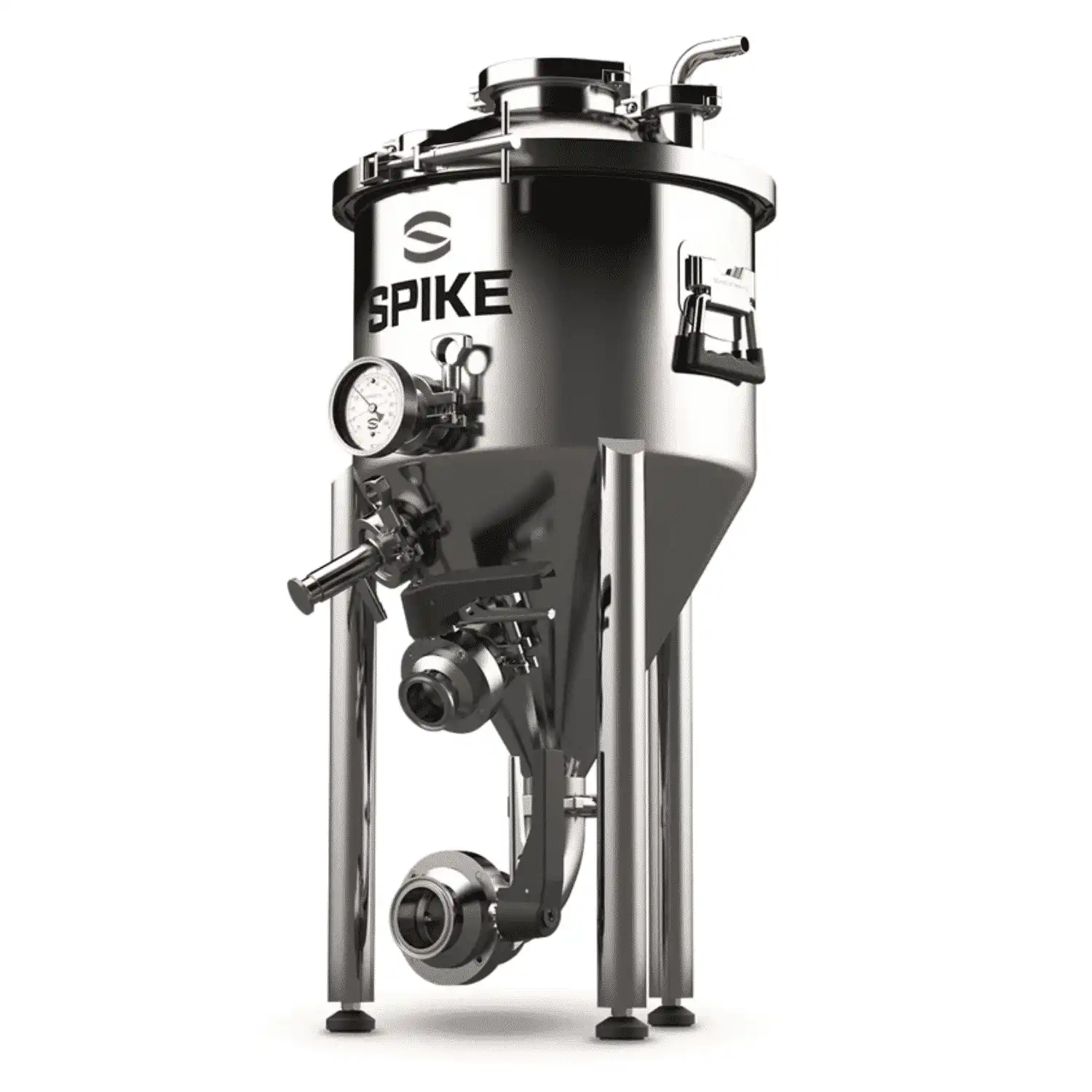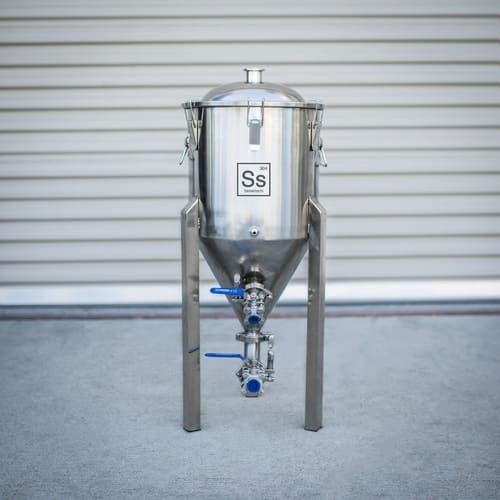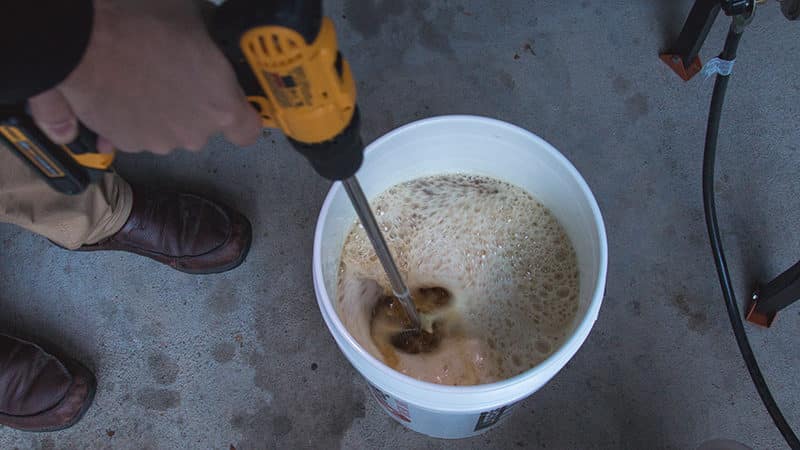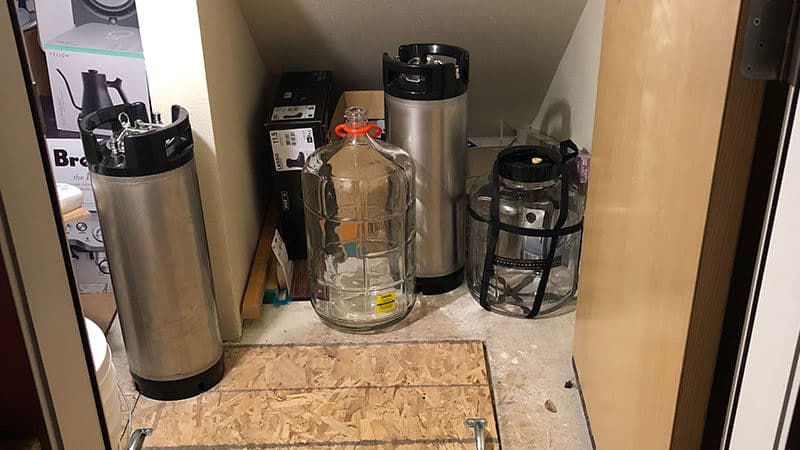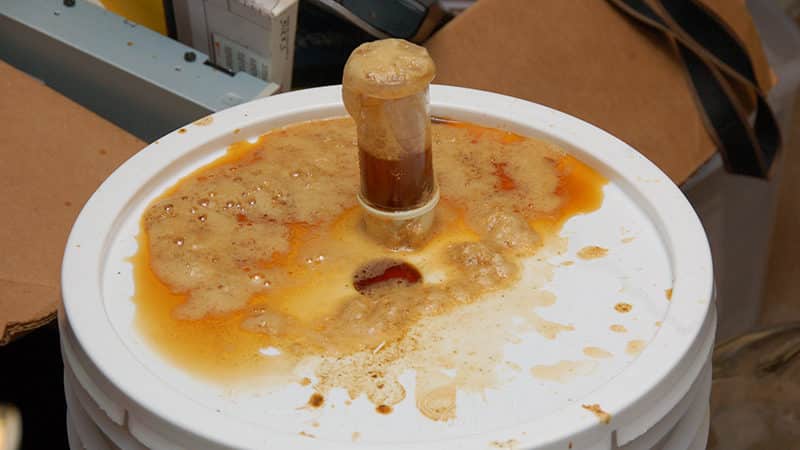Whether you want to stop racking your beer or cut down cleaning time, a conical fermenter might be what you’re looking for. Sure, some of them are expensive. But you pay for quality.
The more ways you can make your brewing efficient, the less time you can spend brewing, and the more time you have to actually enjoy the results.
Our Favorite Stainless Steel Conical Fermenters
We have two favorites from Spike Brewing and Ss BrewTech. Both are incredibly well made, similarly priced, and worth the money.
An absolute beast of a fermenter. One of the best things is its ability to hold up to 15 pounds of pressure for pressurized fermentations.
The Spike CF5 is great because it can do pressurized fermentations. We believe it’s the biggest selling point over every other conical we tried. It can hold up to 15 PSI of pressure.
The Chronical (not a typo—that’s what they call it) is the next best thing when it comes to conical fermenters. This food-grade stainless steel conical fermenter can hold up to seven gallons or more (depending on which size you need). The domed lid seals in place with a molded silicone gasket and six spring-loaded clamps, so no oxygen can ruin your brew.
NOTE: For both of these vessels, we recommend getting the temperature control system and neoprene jacket add-ons.
What is a Conical Fermenter, Anyway?
If you’ve ever visited a large brewery, you may have seen a line of stainless steel tanks with what look like ice cream cone bases. These are just large conical fermenters. Technically they’re cyclio-conical fermenters, but you get the idea.>
The smaller ones for home use are typically shaped like a regular kettle with a cone at the bottom. Some manufacturers offer plastic conical fermenters which may come in more imaginative shapes, like a balloon or lopsided hourglass.
But why does the shape matter? What makes a conical fermenter so great?
No More Racking Your Beer with a Siphon
If you’re using a fermentation bucket—a common tool in beginner homebrewing kits—you want to avoid transferring trub to a secondary fermenter or keg. Trub is a combination of dead proteins, yeast, and wort debris. It forms a sediment which can make your beer hazy. It’s also not appetizing to look at or drink, especially if you’re brewing a lighter beer.
Trub isn’t entirely bad. In your primary fermentation, it may actually give your beer a hoppier and crisper aroma. Just make sure you keep it out of your secondary fermentation.
Conical fermenters allow the trub and yeast to gather at the bottom of the cone. From there, you simply dump the sediment by either removing a containment unit or draining with a hose. That means there’s no need to rack or transfer to a secondary fermenter like a carboy. In short, it makes it easier to brew clear beer.
It’s important to note, however, that while racking to a secondary fermenter was once a must-do part of homebrewing, that advice has fallen by the wayside over the last decade or so. You may still be doing it, but you risk oxidation every time you do.
This is yet another advantage to using a conical fermenter. Not only do you eliminate a labor-intensive step from brewing, you protect your beer from oxidation, and from contamination that can occur during the racking.
More Durability and Less Cleanup
You’ll find a lot of conical fermenters are made of stainless steel, and with good reason. They’re easier to sanitize and last much longer than your typical plastic bucket. Plastic can also be easily scratched, which can create environments for bacteria to hide, survive, and thrive.
Plastic conical fermenters may be less expensive, but they’re not as long-lasting or sanitary as their stainless steel counterparts.
You’re also cutting down on equipment and cleaning by using a conical fermenter. You don’t need to rack, so all that equipment is unnecessary. You may need one hose to siphon off trub, depending on the vessel, but it cuts out any secondary fermentation vessels that you’d still need a hose for anyway.
You Can Reuse Your Yeast
Yes, you read that right. Just as you remove the trub from your beer, you can collect the yeast as well. It can then be washed and reused in a later brew, which can save you money over buying new yeast for every batch. Sound weird? Yeast washing is actually a lot more common than you may think.
Commercial brewers reuse their yeast all the time for a few reasons:
- The cost of yeast can be prohibitive when brewing massive batches.
- Commercial brewers don’t need to store the yeast as long or as often as you probably do for your homebrewing.
- They typically use only one strain of yeast whereas, if you’re like most homebrewers (including us!), you tend to experiment more.
Reusing yeast is not just about saving money. You’ll often get better fermentation on the second batch because the yeast is already alive and active as long as you sanitize and store your yeast properly.
This is especially helpful if you want to brew a high-gravity beer. Brewing a low-gravity beer first builds up more yeast cells to ferment a high-gravity beer on the second round. It’s like a giant yeast starter, except you get another delicious drink.
Ready to improve your all-grain brewing process and dial in your system?
This video course covers techniques and processes for water chemistry, yeast health, mashing, fermentation temperature, dry-hopping, zero-oxygen packaging and more!
Click Here to Learn MoreWhat About Plastic Conical Fermenters?
Plastic may be less durable than steel, but it brings down the price of a new conical fermenter. However, we found plastic fermentors to be harder to clean. Plus, for the money you’re going to spend, they tend to break easily with all the plastic parts.
We recommend if you’re gonna upgrade to a conical fermenter, you might as well go stainless steel for the extra money. The conical will last you a lifetime if you take care of it. And they’re upgradeable over time, no matter which brand you end up with. They all use standard tri-clamp fittings.
Invest In a Conical Fermenter
With proper care, a good conical fermenter can last you a long time. They may be more expensive than your typical fermentation bucket or carboy, but they can pay for themselves in the long run through savings on yeast and replacement homebrewing equipment.
Plus, we think you can work smarter, not harder. Brewing beer takes a lot of effort, but it can be so much easier with a conical fermenter. Give it a try!
Happy Brewing!
